题目四:猫狗队列
【题目】 宠物、狗和猫的类如下:
public class Pet { private String type;
public Pet(String type) { this.type = type; }
public String getPetType() { return this.type; }
}
public class Dog extends Pet { public Dog() { super("dog"); } }
public class Cat extends Pet { public Cat() { super("cat"); } }
实现一种狗猫队列的结构,要求如下: 用户可以调用add方法将cat类或dog类的
实例放入队列中; 用户可以调用pollAll方法,将队列中所有的实例按照进队列
的先后顺序依次弹出; 用户可以调用pollDog方法,将队列中dog类的实例按照
进队列的先后顺序依次弹出; 用户可以调用pollCat方法,将队列中cat类的实
例按照进队列的先后顺序依次弹出; 用户可以调用isEmpty方法,检查队列中是
否还有dog或cat的实例; 用户可以调用isDogEmpty方法,检查队列中是否有dog
类的实例; 用户可以调用isCatEmpty方法,检查队列中是否有cat类的实例。
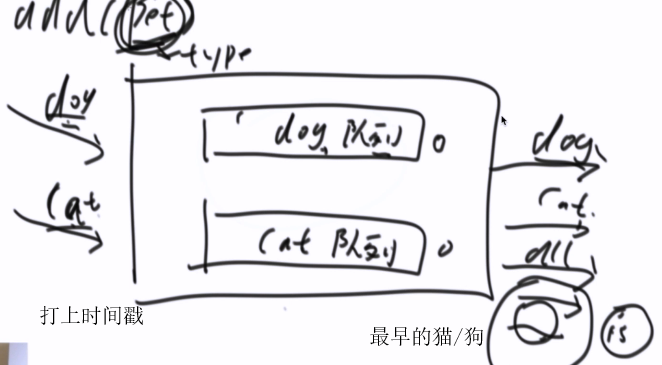
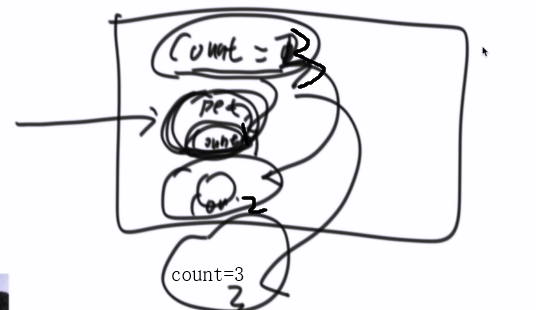
package class_03; import java.util.LinkedList; import java.util.Queue; public class Code_04_DogCatQueue { public static class Pet { private String type; public Pet(String type) { this.type = type; } public String getPetType() { return this.type; } } public static class Dog extends Pet { public Dog() { super("dog"); } } public static class Cat extends Pet { public Cat() { super("cat"); } } public static class PetEnterQueue { private Pet pet; private long count; public PetEnterQueue(Pet pet, long count) { this.pet = pet; this.count = count; } public Pet getPet() { return this.pet; } public long getCount() { return this.count; } public String getEnterPetType() { return this.pet.getPetType(); } } public static class DogCatQueue { private Queue<PetEnterQueue> dogQ; private Queue<PetEnterQueue> catQ; private long count; public DogCatQueue() { this.dogQ = new LinkedList<PetEnterQueue>(); this.catQ = new LinkedList<PetEnterQueue>(); this.count = 0; } public void add(Pet pet) { if (pet.getPetType().equals("dog")) { this.dogQ.add(new PetEnterQueue(pet, this.count++)); } else if (pet.getPetType().equals("cat")) { this.catQ.add(new PetEnterQueue(pet, this.count++)); } else { throw new RuntimeException("err, not dog or cat"); } } public Pet pollAll() { if (!this.dogQ.isEmpty() && !this.catQ.isEmpty()) { if (this.dogQ.peek().getCount() < this.catQ.peek().getCount()) { return this.dogQ.poll().getPet(); } else { return this.catQ.poll().getPet(); } } else if (!this.dogQ.isEmpty()) { return this.dogQ.poll().getPet(); } else if (!this.catQ.isEmpty()) { return this.catQ.poll().getPet(); } else { throw new RuntimeException("err, queue is empty!"); } } public Dog pollDog() { if (!this.isDogQueueEmpty()) { return (Dog) this.dogQ.poll().getPet(); } else { throw new RuntimeException("Dog queue is empty!"); } } public Cat pollCat() { if (!this.isCatQueueEmpty()) { return (Cat) this.catQ.poll().getPet(); } else throw new RuntimeException("Cat queue is empty!"); } public boolean isEmpty() { return this.dogQ.isEmpty() && this.catQ.isEmpty(); } public boolean isDogQueueEmpty() { return this.dogQ.isEmpty(); } public boolean isCatQueueEmpty() { return this.catQ.isEmpty(); } } public static void main(String[] args) { DogCatQueue test = new DogCatQueue(); Pet dog1 = new Dog(); Pet cat1 = new Cat(); Pet dog2 = new Dog(); Pet cat2 = new Cat(); Pet dog3 = new Dog(); Pet cat3 = new Cat(); test.add(dog1); test.add(cat1); test.add(dog2); test.add(cat2); test.add(dog3); test.add(cat3); test.add(dog1); test.add(cat1); test.add(dog2); test.add(cat2); test.add(dog3); test.add(cat3); test.add(dog1); test.add(cat1); test.add(dog2); test.add(cat2); test.add(dog3); test.add(cat3); while (!test.isDogQueueEmpty()) { System.out.println(test.pollDog().getPetType()); } while (!test.isEmpty()) { System.out.println(test.pollAll().getPetType()); } } }
题目五转圈打印矩阵
【题目】 给定一个整型矩阵matrix,请按照转圈的方式打印它。
例如: 1 2 3 4 5 6 7 8 9 10 11 12 13 14
15 16 打印结果为:1,2,3,4,8,12,16,15,14,13,9,
5,6,7,11, 10
【要求】 额外空间复杂度为O(1)。
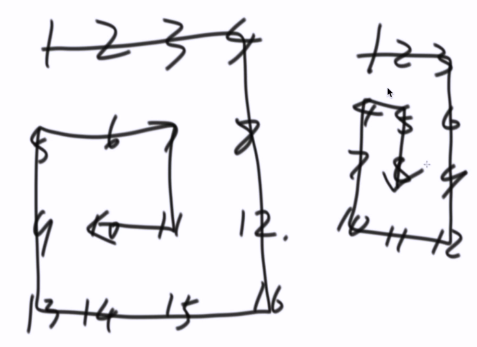
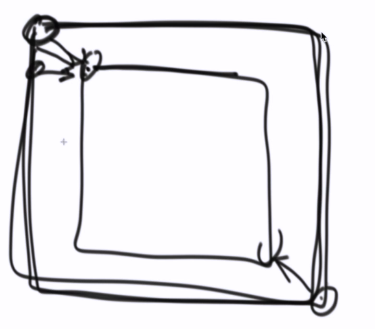
package class_03; public class Code_06_PrintMatrixSpiralOrder { public static void spiralOrderPrint(int[][] matrix) { int tR = 0; int tC = 0; int dR = matrix.length - 1; int dC = matrix[0].length - 1; while (tR <= dR && tC <= dC) { printEdge(matrix, tR++, tC++, dR--, dC--); } } public static void printEdge(int[][] m, int tR, int tC, int dR, int dC) { if (tR == dR) { for (int i = tC; i <= dC; i++) { System.out.print(m[tR][i] + " "); } } else if (tC == dC) { for (int i = tR; i <= dR; i++) { System.out.print(m[i][tC] + " "); } } else { int curC = tC; int curR = tR; while (curC != dC) { System.out.print(m[tR][curC] + " "); curC++; } while (curR != dR) { System.out.print(m[curR][dC] + " "); curR++; } while (curC != tC) { System.out.print(m[dR][curC] + " "); curC--; } while (curR != tR) { System.out.print(m[curR][tC] + " "); curR--; } } } public static void main(String[] args) { int[][] matrix = { { 1, 2, 3, 4 }, { 5, 6, 7, 8 }, { 9, 10, 11, 12 }, { 13, 14, 15, 16 } }; spiralOrderPrint(matrix); } }
题目六:旋转正方形矩阵
【题目】 给定一个整型正方形矩阵matrix,请把该矩阵调整成
顺时针旋转90度的样子。
【要求】 额外空间复杂度为O(1)。
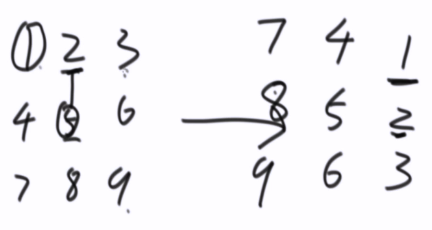
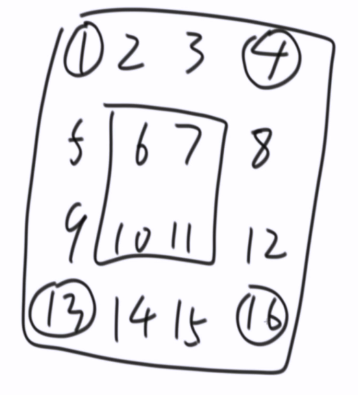
先转外圈
1、 1,4,13,16
2、2,8,15,9
3、5,12,14,5
package class_03; public class Code_05_RotateMatrix { public static void rotate(int[][] matrix) { int tR = 0; int tC = 0; int dR = matrix.length - 1; int dC = matrix[0].length - 1; while (tR < dR) { rotateEdge(matrix, tR++, tC++, dR--, dC--); } } public static void rotateEdge(int[][] m, int tR, int tC, int dR, int dC) { int times = dC - tC; int tmp = 0; for (int i = 0; i != times; i++) { tmp = m[tR][tC + i]; m[tR][tC + i] = m[dR - i][tC]; m[dR - i][tC] = m[dR][dC - i]; m[dR][dC - i] = m[tR + i][dC]; m[tR + i][dC] = tmp; } } public static void printMatrix(int[][] matrix) { for (int i = 0; i != matrix.length; i++) { for (int j = 0; j != matrix[0].length; j++) { System.out.print(matrix[i][j] + " "); } System.out.println(); } } public static void main(String[] args) { int[][] matrix = { { 1, 2, 3, 4 }, { 5, 6, 7, 8 }, { 9, 10, 11, 12 }, { 13, 14, 15, 16 } }; printMatrix(matrix); rotate(matrix); System.out.println("========="); printMatrix(matrix); } }

题目七:转单向和双向链表
【题目】 分别实现反转单向链表和反转双向链表的函数。
【要求】 如果链表长度为N,时间复杂度要求为O(N),额外空间
复杂度要求为O(1)
package class_03; public class Code_07_ReverseList { public static class Node { public int value; public Node next; public Node(int data) { this.value = data; } } public static Node reverseList(Node head) { Node pre = null; Node next = null; while (head != null) { next = head.next; head.next = pre; pre = head; head = next; } return pre; } public static class DoubleNode { public int value; public DoubleNode last; public DoubleNode next; public DoubleNode(int data) { this.value = data; } } public static DoubleNode reverseList(DoubleNode head) { DoubleNode pre = null; DoubleNode next = null; while (head != null) { next = head.next; head.next = pre; head.last = next; pre = head; head = next; } return pre; } public static void printLinkedList(Node head) { System.out.print("Linked List: "); while (head != null) { System.out.print(head.value + " "); head = head.next; } System.out.println(); } public static void printDoubleLinkedList(DoubleNode head) { System.out.print("Double Linked List: "); DoubleNode end = null; while (head != null) { System.out.print(head.value + " "); end = head; head = head.next; } System.out.print("| "); while (end != null) { System.out.print(end.value + " "); end = end.last; } System.out.println(); } public static void main(String[] args) { Node head1 = new Node(1); head1.next = new Node(2); head1.next.next = new Node(3); printLinkedList(head1); head1 = reverseList(head1); printLinkedList(head1); DoubleNode head2 = new DoubleNode(1); head2.next = new DoubleNode(2); head2.next.last = head2; head2.next.next = new DoubleNode(3); head2.next.next.last = head2.next; head2.next.next.next = new DoubleNode(4); head2.next.next.next.last = head2.next.next; printDoubleLinkedList(head2); printDoubleLinkedList(reverseList(head2)); } }
题目八:“之”字形打印矩阵
【题目】 给定一个矩阵matrix,按照“之”字形的方式打印这
个矩阵,例如: 1 2 3 4 5 6 7 8 9 10 11 12
“之”字形打印的结果为:1,2,5,9,6,3,4,7,10,11,
8,12
【要求】 额外空间复杂度为O(1)。

coding:对数据加工的一种技巧
设计宏观结构
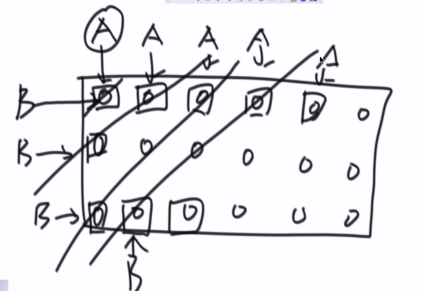
bool类型
A--> 往左,到边界向下
B--> 往下,到边界往右
每次打印对角线,AB分开移动
package class_03; public class Code_08_ZigZagPrintMatrix { public static void printMatrixZigZag(int[][] matrix) { int tR = 0; int tC = 0; int dR = 0; int dC = 0; int endR = matrix.length - 1; int endC = matrix[0].length - 1; boolean fromUp = false; while (tR != endR + 1) { printLevel(matrix, tR, tC, dR, dC, fromUp); tR = tC == endC ? tR + 1 : tR; tC = tC == endC ? tC : tC + 1; dC = dR == endR ? dC + 1 : dC; dR = dR == endR ? dR : dR + 1; fromUp = !fromUp; } System.out.println(); } public static void printLevel(int[][] m, int tR, int tC, int dR, int dC, boolean f) { if (f) { while (tR != dR + 1) { System.out.print(m[tR++][tC--] + " "); } } else { while (dR != tR - 1) { System.out.print(m[dR--][dC++] + " "); } } } public static void main(String[] args) { int[][] matrix = { { 1, 2, 3, 4 }, { 5, 6, 7, 8 }, { 9, 10, 11, 12 } }; printMatrixZigZag(matrix); } }
“宏观”解决打印问题
题目九:在行列都排好序的矩阵中找数
【题目】 给定一个有N*M的整型矩阵matrix和一个整数K,
matrix的每一行和每一 列都是排好序的。实现一个函数,判断K
是否在matrix中。 例如: 0 1 2 5 2 3 4 7 4
4 4 8 5 7 7 9 如果K为7,返回true;如果K为6,返
回false。
【要求】 时间复杂度为O(N+M),额外空间复杂度为O(1)。
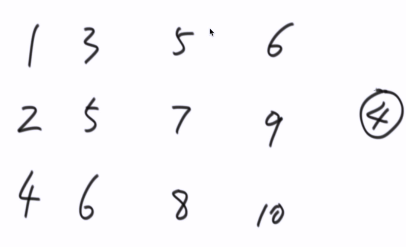

package class_03; public class Code_09_FindNumInSortedMatrix { public static boolean isContains(int[][] matrix, int K) { int row = 0; int col = matrix[0].length - 1; while (row < matrix.length && col > -1) { if (matrix[row][col] == K) { return true; } else if (matrix[row][col] > K) { col--; } else { row++; } } return false; } public static void main(String[] args) { int[][] matrix = new int[][] { { 0, 1, 2, 3, 4, 5, 6 },// 0 { 10, 12, 13, 15, 16, 17, 18 },// 1 { 23, 24, 25, 26, 27, 28, 29 },// 2 { 44, 45, 46, 47, 48, 49, 50 },// 3 { 65, 66, 67, 68, 69, 70, 71 },// 4 { 96, 97, 98, 99, 100, 111, 122 },// 5 { 166, 176, 186, 187, 190, 195, 200 },// 6 { 233, 243, 321, 341, 356, 370, 380 } // 7 }; int K = 233; System.out.println(isContains(matrix, K)); } }
两大思路
一个题的最优解来自这个题目的 数据状况
一个题的最优解来自这个题目的 本身问法
题目十:打印两个有序链表的公共部分
【题目】 给定两个有序链表的头指针head1和head2,打印两个
链表的公共部分。
类似快排中的merge
package class_03; public class Code_10_PrintCommonPart { public static class Node { public int value; public Node next; public Node(int data) { this.value = data; } } public static void printCommonPart(Node head1, Node head2) { System.out.print("Common Part: "); while (head1 != null && head2 != null) { if (head1.value < head2.value) { head1 = head1.next; } else if (head1.value > head2.value) { head2 = head2.next; } else { System.out.print(head1.value + " "); head1 = head1.next; head2 = head2.next; } } System.out.println(); } public static void printLinkedList(Node node) { System.out.print("Linked List: "); while (node != null) { System.out.print(node.value + " "); node = node.next; } System.out.println(); } public static void main(String[] args) { Node node1 = new Node(2); node1.next = new Node(3); node1.next.next = new Node(5); node1.next.next.next = new Node(6); Node node2 = new Node(1); node2.next = new Node(2); node2.next.next = new Node(5); node2.next.next.next = new Node(7); node2.next.next.next.next = new Node(8); printLinkedList(node1); printLinkedList(node2); printCommonPart(node1, node2); } }
链表问题
空间复杂度O(1) 面试中重点是O(1)
时间复杂度O(n)
如果用辅助空间,下面的题目都很easy
题目十一:判断一个链表是否为回文结构
【题目】 给定一个链表的头节点head,请判断该链表是否为回
文结构。 例如: 1->2->1,返回true。 1->2->2->1,返回true。
15->6->15,返回true。 1->2->3,返回false。
进阶: 如果链表长度为N,时间复杂度达到O(N),额外空间复杂
度达到O(1)。
1、放入栈 O(N)
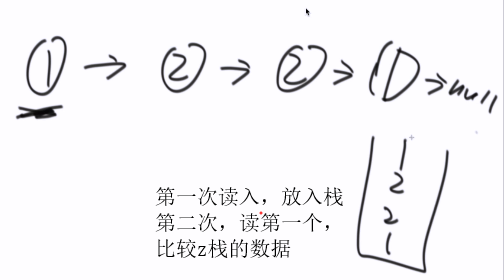
2、快慢指针 O(N/2)
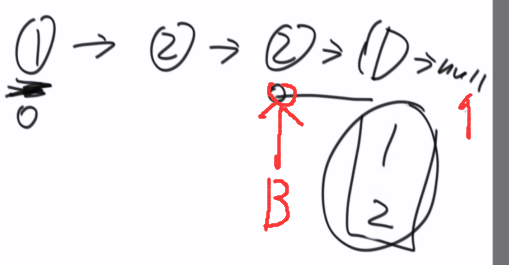
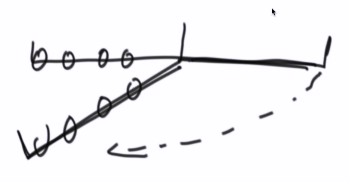
3、面试中,快慢指针 O(1)
完美解法
快指针 2步,走完
慢指针1步,重点
右半部分逆序

一一比对,相同的话,True,False
数据要恢复回来
package class_03; import java.util.Stack; public class Code_11_IsPalindromeList { public static class Node { public int value; public Node next; public Node(int data) { this.value = data; } } // need n extra space public static boolean isPalindrome1(Node head) { Stack<Node> stack = new Stack<Node>(); Node cur = head; while (cur != null) { stack.push(cur); cur = cur.next; } while (head != null) { if (head.value != stack.pop().value) { return false; } head = head.next; } return true; } // need n/2 extra space public static boolean isPalindrome2(Node head) { if (head == null || head.next == null) { return true; } Node right = head.next; Node cur = head; while (cur.next != null && cur.next.next != null) { right = right.next; cur = cur.next.next; } Stack<Node> stack = new Stack<Node>(); while (right != null) { stack.push(right); right = right.next; } while (!stack.isEmpty()) { if (head.value != stack.pop().value) { return false; } head = head.next; } return true; } // need O(1) extra space public static boolean isPalindrome3(Node head) { if (head == null || head.next == null) { return true; } Node n1 = head; Node n2 = head; while (n2.next != null && n2.next.next != null) { // find mid node n1 = n1.next; // n1 -> mid n2 = n2.next.next; // n2 -> end } n2 = n1.next; // n2 -> right part first node n1.next = null; // mid.next -> null Node n3 = null; while (n2 != null) { // right part convert n3 = n2.next; // n3 -> save next node n2.next = n1; // next of right node convert n1 = n2; // n1 move n2 = n3; // n2 move } n3 = n1; // n3 -> save last node n2 = head;// n2 -> left first node boolean res = true; while (n1 != null && n2 != null) { // check palindrome if (n1.value != n2.value) { res = false; break; } n1 = n1.next; // left to mid n2 = n2.next; // right to mid } n1 = n3.next; n3.next = null; while (n1 != null) { // recover list n2 = n1.next; n1.next = n3; n3 = n1; n1 = n2; } return res; } public static void printLinkedList(Node node) { System.out.print("Linked List: "); while (node != null) { System.out.print(node.value + " "); node = node.next; } System.out.println(); } public static void main(String[] args) { Node head = null; printLinkedList(head); System.out.print(isPalindrome1(head) + " | "); System.out.print(isPalindrome2(head) + " | "); System.out.println(isPalindrome3(head) + " | "); printLinkedList(head); System.out.println("========================="); head = new Node(1); printLinkedList(head); System.out.print(isPalindrome1(head) + " | "); System.out.print(isPalindrome2(head) + " | "); System.out.println(isPalindrome3(head) + " | "); printLinkedList(head); System.out.println("========================="); head = new Node(1); head.next = new Node(2); printLinkedList(head); System.out.print(isPalindrome1(head) + " | "); System.out.print(isPalindrome2(head) + " | "); System.out.println(isPalindrome3(head) + " | "); printLinkedList(head); System.out.println("========================="); head = new Node(1); head.next = new Node(1); printLinkedList(head); System.out.print(isPalindrome1(head) + " | "); System.out.print(isPalindrome2(head) + " | "); System.out.println(isPalindrome3(head) + " | "); printLinkedList(head); System.out.println("========================="); head = new Node(1); head.next = new Node(2); head.next.next = new Node(3); printLinkedList(head); System.out.print(isPalindrome1(head) + " | "); System.out.print(isPalindrome2(head) + " | "); System.out.println(isPalindrome3(head) + " | "); printLinkedList(head); System.out.println("========================="); head = new Node(1); head.next = new Node(2); head.next.next = new Node(1); printLinkedList(head); System.out.print(isPalindrome1(head) + " | "); System.out.print(isPalindrome2(head) + " | "); System.out.println(isPalindrome3(head) + " | "); printLinkedList(head); System.out.println("========================="); head = new Node(1); head.next = new Node(2); head.next.next = new Node(3); head.next.next.next = new Node(1); printLinkedList(head); System.out.print(isPalindrome1(head) + " | "); System.out.print(isPalindrome2(head) + " | "); System.out.println(isPalindrome3(head) + " | "); printLinkedList(head); System.out.println("========================="); head = new Node(1); head.next = new Node(2); head.next.next = new Node(2); head.next.next.next = new Node(1); printLinkedList(head); System.out.print(isPalindrome1(head) + " | "); System.out.print(isPalindrome2(head) + " | "); System.out.println(isPalindrome3(head) + " | "); printLinkedList(head); System.out.println("========================="); head = new Node(1); head.next = new Node(2); head.next.next = new Node(3); head.next.next.next = new Node(2); head.next.next.next.next = new Node(1); printLinkedList(head); System.out.print(isPalindrome1(head) + " | "); System.out.print(isPalindrome2(head) + " | "); System.out.println(isPalindrome3(head) + " | "); printLinkedList(head); System.out.println("========================="); } }
左神:推荐用C++代码
不要求有语言特性
比如 range(len(array))
题目十二:将单向链表按某值划分成左边小、中间相等、右边大的形式
荷兰国旗问题
【题目】 给定一个单向链表的头节点head,节点的值类型是整型,再给定一个
整 数pivot。实现一个调整链表的函数,将链表调整为左部分都是值小于 pivot
的节点,中间部分都是值等于pivot的节点,右部分都是值大于 pivot的节点。
除这个要求外,对调整后的节点顺序没有更多的要求。 例如:链表9->0->4->5-
>1,pivot=3。 调整后链表可以是1->0->4->9->5,也可以是0->1->9->5->4。总
之,满 足左部分都是小于3的节点,中间部分都是等于3的节点(本例中这个部
分为空),右部分都是大于3的节点即可。对某部分内部的节点顺序不做 要求。
与面试官聊天
1、什么是稳定性
2、荷兰国旗不具有稳定性
3、链表问题可以省略空间完成
4、你coding达标
进阶: 在原问题的要求之上再增加如下两个要求。
在左、中、右三个部分的内部也做顺序要求,要求每部分里的节点从左 到右的
顺序与原链表中节点的先后次序一致。 例如:链表9->0->4->5->1,pivot=3。
调整后的链表是0->1->9->4->5。 在满足原问题要求的同时,左部分节点从左到
右为0、1。在原链表中也 是先出现0,后出现1;中间部分在本例中为空,不再
讨论;右部分节点 从左到右为9、4、5。在原链表中也是先出现9,然后出现4,
最后出现5。
如果链表长度为N,时间复杂度请达到O(N),额外空间复杂度请达到O(1)。